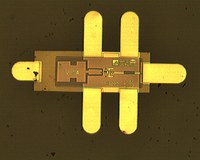Millimeter & Sub-Millimeter Detectors - Evolving ALMA to its full potential

ALMA Band 6 (211-275 GHz) 2SB SIS mixer.
The current generation of mm/sub-mm SIS (Superconductor-Insulator-Superconductor) receivers, as used on all the higher frequency bands of ALMA, was the result of a long period of development at the CDL in collaboration with the University of Virginia Microfabrication Laboratory (UVML). This includes the introduction of niobium-based superconducting circuits for radio astronomy, development of wideband SIS mixer MMICs, and the use of sideband-separating SIS mixers which were pioneered at the CDL. The CDL was responsible for the development and production of the ALMA band 6 (211-275 GHz) receivers as well as development of the SIS mixers used in the band 3 (84-116 GHz) receivers.
CDL Sub-Millimeter Development Areas
- Nb/Al-AlN/Nb second-generation ALMA band 6 (211-275 GHz) balanced 2SB SIS mixer
- Balanced 2SB Nb/Al-AlN/NbTiN ALMA band 10 (787-950 GHz) SIS mixer
- IEEE standard for ring-centered THz waveguide flange
- Local oscillators for THz heterodyne mixers


385-500 GHz SIS mixer chip (left) on 3 micron silicon membrane with gold beamleads for easy assembly. Magnified view (right) of SIS junctions and matching circuitry.




Connect with NRAO